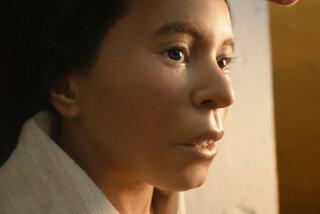‘Mummies of the World’ at California Science Center
- Share via
Late last month, a convoy of climate-controlled trucks swept from LAX to the California Science Center escorted by a phalanx of police. The contents of the trucks: mummies. It could have been the opening scene for a new summer thriller, but these mummies are real — and they are meant for more than entertainment. They comprise the Science Center’s high-profile summer exhibit, “Mummies of the World,” which makes its world premiere Thursday and runs through Nov. 28.
The precious cargo, culled from more than 20 museums and seven countries, includes a previously unseen selection of 150 human and animal mummies and an assortment of burial artifacts that include amulets, statues and fragments from the “Book of the Dead.”
“There’s far more to mummification than the wrapped Egyptians people automatically think of,” says Heather Gill-Frerking, the exhibit’s director of science and education. “We wanted to present as many different types of mummies from as many different environments as we can.”
She cites exhibit subjects such as the Detmold child, a Peruvian child mummy that dates back 6,420 years, or Baron von Holz, an 11th century nobleman discovered in the family crypt of his castle. Don’t forget the entire 18th century Orlovits family, found in a church crypt in rural Hungary. The animal exhibits include a mummified howler monkey from Argentina and a Saharan desert lizard mummy. “We wanted to present the wide spectrum of mummification that exists, both natural and artificial,” says Gill-Frerking, pointing to the fact that natural environments such as deserts, bogs and glaciers can preserve the dead just as effectively as the culturally and spiritually motivated embalming practices of humans.
Previous mummy exhibits have drawn criticism for displaying specimens acquired from questionable sources, but the Mummies of the World organizers have taken great pains to ensure that the exhibit was assembled ethically and with reverence.
“We treat every mummy as if it’s a human, living patient,” says Gill-Frerking. “We’re cautious of how they’re handled, we maintain noninvasive, non-destructive analyses and we’re very respectful of the culture from which they originated.” In fact, the descendents of Baron von Holz, who still live in the family castle, have been actively involved in the research conducted on their preserved forebear.
That unusual mix of science and spirituality is one of the elements that makes Mummies of the World unique. The exhibit offers visitors state-of-the-art multimedia and hands-on interactive stations where users utilize 3-D animation to tackle such questions as how mummies are created, how decomposition works, and what secrets can be revealed by ancient hair and fibers.
“One of the questions I’m most asked is ‘What do they feel like?’ ” says James Delay, vice president of Americans Exhibitions Inc., the exhibition’s producer. He adds, “At the museum you’ll be able to touch samples of representations of what a mummy would feel like. We have five science kiosks with touch screens where you’ll be able to see the tools scientists use to do their studies.”
Those tools can reveal what kinds of foods ancient people ate, what diseases plagued them and what types of clothing and jewelry they favored, ultimately painting a detailed portrait of how cultures change over time. Such knowledge can inform us in more intimate ways too.
“Most of us have a fear or taboo of death,” Gill-Frerking says. “This opens [our] eyes to something that shows death in a more beautiful way. But it’s also coming to terms with our own mortality and knowing that parts of us will somehow live on as well.”
Where: California Science Center, 700 Exposition Park Drive, L.A.
When: 10 a.m.-5 p.m. daily through Nov. 28. Closed Thanksgiving.
Price: Adult $19.50; children 4-12 $12.50; seniors, students and children 13-17 $16.50.
Contact: (213) 744-2019; www.mummiesoftheworld.com
More to Read
The biggest entertainment stories
Get our big stories about Hollywood, film, television, music, arts, culture and more right in your inbox as soon as they publish.
You may occasionally receive promotional content from the Los Angeles Times.










